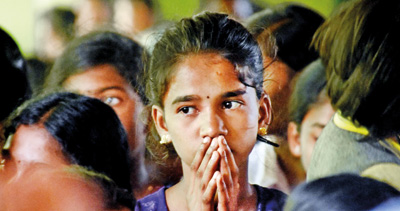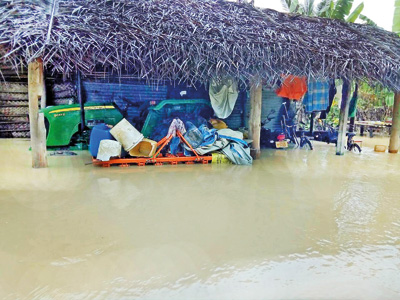News
Did negligence drown Kilinochchi in floody misery?
A three-member fact-finding committee is investigating whether negligent provincial irrigation officials contributed towards the destructive floods that caused havoc in the Kilinochchi District last week.

What lies ahead?A young displaced girl looks on in anguish. Pix by Sanath Priyantha Hewage
Set up by Northern Province Governor Reginald Cooray, the committee is tasked with probing claims that the water level of the Iranamadu tank was allowed to reach 39.5 feet (3.5 feet above the stipulated maximum water level), resulting in spills over the structure. All of the tank’s sluice gates were then reportedly opened in full, abruptly, resulting in severe flood damage downstream.
The committee will look into whether officials at the Provincial Irrigation Department were responsible for bad flood management and opening of gates, giving inadequate warning to those living downstream to evacuate in time. If official negligence is confirmed, they will identify those responsible.
The team is headed by Prof S S Sivakumar of the Faculty of Engineering, University of Jaffna. Other members are Eng S Shanmugananthan, Deputy Chief Secretary Engineering Services (Northern Province), and S Sivakumar, Provincial Director of Agriculture.
When the water level of the Kanakarayan Aru (Kanakarayan River) rises, the Iranamadu tank’s sluice gates should be opened one by one, said a retired irrigation engineer on condition of anonymity. The river is connected to the tank.
“When the area was under LTTE control, they would send a man to Mankulam with a walkie-talkie,” he recalled. “If the flood level was increasing in the Mankulam area, he would inform those at the Iranamadu tank. Then they would open the gates one by one.”
Renovation of the Iranamadu tank, funded by the Asian Development Bank, raised its water level from 34 to 36 feet. Torrential rains lashed Kilinochchi district on Friday evening. Between 375-400mm of rain — almost a quarter of the area’s annual rainfall — was received in a matter of hours.

Destructive floods caused havoc in Kilinochchi last week
The tank has radial gates which should have been opened much earlier, the engineer said. These are situated at a lower depth to the sluice gates and should have been released when the water level was at 34 feet.
“The operation system the Provincial Irrigation Department adopted was completely wrong,” he reiterated. “The radial gates should have been opened at 34 feet to let out water to ensure there was no chance of spillage over the tank in an emergency situation. Yet, the Department had maintained the water level at its maximum depth of 36 feet before the rains, on bad advice that it would enable farmers to engage in cultivation the whole year.”
“In the end, water spilled over the structure and the sluice gates were hastily opened,” he claimed. “This is the reason for the disaster.” He suspected that there was a communication gap between the Mankulam Irrigation Department office and the Kilinochchi office.
A senior military officer said they, too, had seen water spilling over the tank on December 21 evening. He declined to be named.
Some residents, who were in camps set up for those displaced by flooding, said they were warned by their respective Grama Niladharis on December 21 night to evacuate as water levels were rising. A significant number, however, had chosen to stay put. They also said no warnings were given to those living further in the interior.
Flooding was experienced from about 3 am on Saturday, December 22. By about 10-11am, much of the region was underwater, those affected said.
A senior irrigation engineer from the Northern Province Irrigation Department refuted the allegations, saying they had followed their Department’s standing orders when releasing water from the Iranamadu tank.
Meanwhile, Prime Minister Ranil Wickremesinghe, who visited the region on Friday to assess the situation, said at a meeting in the Kilinochchi District Secretariat that loan and interest repayments would be suspended for those hit by floods. He also instructed the District Secretary to prevent agents of micro finance companies from entering camps of the displaced, following complaints that some people had even been harassed inside these locations over non-payment of loans.

Big and small roads, around 1,430 kilometres in total extent, were affected
Every affected family is to receive Rs10,000 as initial assistance. The PM said that 38,000 families in Kilinochchi and Mullaitivu have been affected by the floods, with houses and businesses severely hit. As the two regions were two of the most underdeveloped in the country, the impact is much greater, he acknowledged.
Additional Reporting by Sanath Priyantha and N Parameswaran

